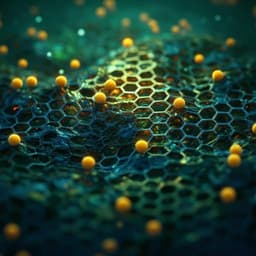
Physics
Electron shelving of a superconducting artificial atom
N. Cottet, H. Xiong, et al.
This groundbreaking research by Nathanaël Cottet, Haonan Xiong, Long B. Nguyen, Yen-Hsiang Lin, and Vladimir E. Manucharyan explores an innovative cavityless approach for interfacing long-lived qubits with photons, achieving impressive outcomes in qubit coherence and readout accuracy.
~3 min • Beginner • English
Introduction
The study addresses whether the cavity used in standard cQED architectures can be eliminated by exploiting a three-level superconducting circuit atom with distinct dark (long-lived qubit) and bright (cycling) transitions, akin to electron shelving in atomic physics. Conventional transmon and flux qubits lack sufficient diversity in transition frequencies and selection rules to enable direct, cavityless control with both long coherence and QND readout. The authors propose using fluxonium, whose strong anharmonicity and parity selection enable a low-frequency qubit transition coexisting with a high-frequency cycling transition. The purpose is to realize conditional fluorescence (electron shelving) directly into a transmission line while maintaining high qubit coherence, thereby enabling a direct qubit–photon interface, facilitating quantum networking, and potentially reducing on-chip footprint in scalable processors.
Literature Review
Prior work in cQED has demonstrated strong coupling and resonance fluorescence with superconducting qubits, typically mediated by off-resonant cavities for QND dispersive readout. Single-photon scattering with flux qubits and fluorescence with transmons established foundational microwave quantum optics experiments. However, due to limited selection rules, these platforms have relied on cavities to achieve state-of-the-art coherence and readout. Electron shelving, extensively used in atomic physics and optical clocks, leverages a metastable state and a bright cycling transition to enable conditional fluorescence and QND measurements. Waveguide QED advances show photon-mediated interactions and giant-atom effects relevant for direct interfaces. The paper positions fluxonium’s intrinsic anharmonicity and selection rules as a natural route to implement shelving in a superconducting circuit without a cavity, contrasting with more complex V- and Λ-type circuit implementations.
Methodology
Device and transitions: The experiment uses a fluxonium circuit (a Josephson junction shunted by a superinductance and antenna capacitance) operated near half-integer flux bias Φext=π. The qubit states |0⟩ and |1⟩ are split by ω01/2π≈1.152 GHz. A bright cycling transition |0⟩↔|3⟩ at ω03/2π=6.544 GHz is selected; even-parity transitions are dipole-forbidden at the sweet spot, suppressing |3⟩→|1⟩.
Coupling architecture: The chip is mounted in a copper enclosure with a specially designed single-port coaxial-to-TE mode adapter creating a low-frequency cutoff near ω03. This engineering yields strong radiative coupling for |0⟩↔|3⟩ while suppressing coupling at the qubit frequency, protecting |0⟩↔|1⟩ coherence. TE cutoff also suppresses |3⟩→|2⟩ radiative decay; parity selection suppresses |3⟩→|1⟩.
Readout principle and detection: Conditional fluorescence from the cycling transition is monitored via homodyne reflection (phase-sensitive detection). Using input–output theory for a single port and assuming zero-temperature environment within the cycling manifold, the complex reflection coefficient r=rout/rin relates to the ground-state population ρ0 as r=1−2ρ0[(Γ2/2−iΓ(ω−ω03))/(Γ2/2+Ω2+(ω−ω03)2)], where Γ is the |3⟩→|0⟩ radiative rate and Ω the Rabi rate. Fluorescence power ∝|1−r|2 is maximized at Ω=Γ/√2 and ω=ω03, where r=1−ρ0.
Calibration and protocols: The reflection coefficient is absolutely calibrated by measuring a background response Scal(ω) at a flux with no transitions in-band (6.3–6.6 GHz), then normalizing experimental data Sexp(ω) using the known room-temperature drive powers. Readout sequences include a wait τw=0.5 µs to reach steady state (≫1/Γ≈91 ns) followed by integration T=0.5 µs. Time-domain control uses standard pulses at ω01 for Rabi, relaxation (π-pulse then wait), and spin-echo at slightly off-sweet-spot conditions; strong driving of |1⟩→|3⟩ is used for enhanced initialization.
Transient and relaxation modeling: Population dynamics during prolonged cycling and free evolution from |2⟩ are measured using swap operations to map populations to |0⟩ before readout. A relaxation model includes radiative decay in the line, dielectric loss, and quasiparticle tunneling, all parameterized at an effective bath temperature near 45–50 mK. Rates are computed from fluxonium eigenstates; master equation simulations (QuTiP) with up to the first ten eigenstates and jump operators Lij=√Γij|i⟩⟨j| reproduce the observed transients. Fitting yields Qdiel≈5×10^5, quasiparticle density χqp≈10−6, and a modest empirical factor on |3⟩→|2⟩ to capture a nearby two-level fluctuator. The optimal readout drive during transients is Ω≈0.95Γ/√2.
Key Findings
- Successful cavityless conditional fluorescence (electron shelving) readout of a fluxonium qubit directly coupled to a microwave waveguide, with strong separation between qubit and cycling transitions.
- Spectroscopy of |0⟩↔|3⟩ fits the input–output model with only four global parameters: ω03/2π=6.544 GHz, Γ=2π×1.74 MHz (radiative lifetime 1/Γ≈91 ns), thermal ground-state population ρth≈0.78, and a drive-scaling factor.
- Absolute calibration enables direct mapping of reflection to ground-state population; repeated over 5 days gives p0th=0.76±0.03, corresponding to an effective temperature T=45±5 mK.
- Time-domain control demonstrated: Rabi oscillations on |0⟩↔|1⟩; energy relaxation and spin-echo decays both exponential with T1≈T2≈52 µs, nearly three orders longer than the cycling state lifetime.
- Decoherence analysis: T1 likely limited by dielectric loss in the antenna capacitance with effective Qdiel≈5×10^5; additional dephasing consistent with thermal photons near ω03 inducing upward |0⟩→|3⟩ jumps at a rate ΓJ=Γ exp(−ħω03/kBT).
- QND character: During continuous readout drive, population leaks from the cycling manifold with a fluorescence lifetime Tcyc≈9.6 µs, involving mainly states |1⟩ and |2⟩; average number of fluorescence cycles Ncyc≈Γ×Tcyc≈105.
- Error channels quantified: Dominant readout error from non-radiative |3⟩→|2⟩ due to dielectric loss with characteristic time ≈3.6 µs; smaller contribution from parity-breaking |3⟩→|1⟩ due to quasiparticles with characteristic time ≈36 µs. A nearby two-level fluctuator may enhance |3⟩→|2⟩ by a factor ≈2.5.
- Initialization improvement: Driving |1⟩→|3⟩ followed by spontaneous emission |3⟩→|0⟩ increases p0 to ≈0.9 via optical pumping into the measurement line.
Discussion
The results directly answer the central question: a superconducting three-level circuit atom (fluxonium) can provide both a long-lived qubit transition and a bright cycling transition enabling QND readout without an intermediate cavity. Engineering a frequency-selective coupling via a TE-mode cutoff, together with fluxonium’s parity selection rule, yields a strong, conditional fluorescence signal while preserving qubit coherence (T1≈T2≈52 µs). The input–output model accurately captures the calibrated reflection response, validating the conditional nature of the measured fluorescence. The observed readout-induced population dynamics are well explained by a minimal optical pumping model with realistic non-radiative channels (dielectric loss and quasiparticles), quantifying deviations from ideal QND behavior through Tcyc and Ncyc. The cavityless interface provides a resource-efficient alternative to dispersive cQED, with implications for waveguide QED, quantum networking, and on-chip space savings. Thermal photon occupation near the cycling frequency is identified as a dephasing mechanism but can be mitigated by improved thermalization. The approach supports future single-shot QND readout with parametric amplification and may enable photon routing and distributed computation protocols using the same node as emitter and memory.
Conclusion
This work demonstrates electron shelving in a superconducting fluxonium qubit directly coupled to a waveguide, achieving a QND conditional-fluorescence readout without a cavity while maintaining long qubit coherence (T1,T2≈52 µs) and a fast cycling transition (≈91 ns lifetime). Absolute calibration of the fluorescence-based reflection enables quantitative population measurements and modeling. The dominant non-QND errors arise from dielectric-loss–induced |3⟩→|2⟩ decay and, to a lesser extent, quasiparticle-assisted |3⟩→|1⟩ decay. The cavityless architecture offers a compact, efficient interface to propagating photons suitable for waveguide QED and quantum networking. Future directions include using |1⟩→|2⟩ for cycling to push Tcyc to the T1 limit, replacing the 3D coupler with on-chip capacitive coupling while retaining low-frequency emission suppression, implementing near-quantum-limited parametric amplification for single-shot readout, integrating microwave photon counters, and improving thermalization to suppress dephasing from hot photons.
Limitations
- Thermal population and hot-photon occupation (T≈45±5 mK) introduce dephasing via upward |0⟩→|3⟩ jumps and reduce initialization fidelity absent active cooling.
- Non-radiative decay channels limit QND performance: dominant dielectric loss causing |3⟩→|2⟩ (≈3.6 µs) and smaller quasiparticle-induced |3⟩→|1⟩ (≈36 µs); a nearby two-level fluctuator may enhance certain decay rates.
- Fluorescence lifetime Tcyc≈9.6 µs sets a finite number of cycles (Ncyc≈105), limiting readout duration and fidelity compared to an ideal QND measurement.
- Single-shot readout was not demonstrated; achieving it likely requires a near-quantum-limited parametric amplifier.
- Swap-gate fidelities (≥99% for |0⟩↔|1⟩, ≥90% for |0⟩↔|2⟩) bound the accuracy of transient population measurements.
- The model assumes a uniform bath temperature and requires empirical adjustment for |3⟩→|2⟩, indicating residual unmodeled defects.
Related Publications
Explore these studies to deepen your understanding of the subject.







